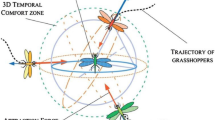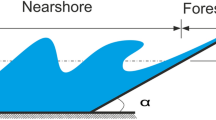Abstract
The line and slope fine-tuning is the process of optimizing the horizontal and longitudinal sections to meet the requirements of building clearance, which is an indispensable step in the building engineering. The traditional line and slope fine-tuning, which is manually completed by designers, depends heavily on the domain knowledge of designers. The more experienced the designer is, the better the effect of line and slope fine-tuning will be. This paper makes a first attempt to apply the evolutionary algorithm to the process of line and slope fine-tuning. The main work includes: a new denoising method for tunnel point cloud data is proposed to remove noisy and redundant data from point cloud; an objective function is given to measure the deviation between the design tunnel and the real tunnel; and a learning model of the line and slope fine-tuning is built based on the point cloud data and evolutionary algorithm. A dataset from a length of the real metro tunnel is used for model testing. The testing results show that, in comparison with the traditional manually-adjusting method, our approach based on the evolutionary algorithm can significantly reduce the deviation between the adjusted tunnel and the real tunnel.













Similar content being viewed by others
References
Argüelles-Fraga R, Ordóñez C, García-Cortés S, Roca-Pardiñas J (2013) Measurement planning for circular cross-section tunnels using terrestrial laser scanning. Autom Constr 31:1–9
Bellman R (1966) Dynamic programming. Science 153(3731):34–37
Ding L, Zhang L, Xianguo W, Skibniewski MJ, Qunzhou Y (2014) Safety management in tunnel construction: case study of Wuhan metro construction in china. Saf Sci 62:8–15
Dong C, Ng WWY, Wang X, Chan PPK, Yeung DS (2014) An improved differential evolution and its application to determining feature weights in similarity-based clustering. Neurocomputing 146:95–103
Du L, Zhong R Sun H, Wu Q (2017) Automatic monitoring of tunnel deformation based on high density point clouds data. The International Archives of the Photogrammetry, Remote Sensing and Spatial Information Sciences, Volume XLII-2/W7, 2017 ISPRS Geospatial Week 2017, 18–22 September 2017, Wuhan, China
Easa SM (1988) Earthwork allocations with linear unit costs. J Constr Eng Manag 114(4):641–655
Fogel DB (1997) Evolutionary algorithms in theory and practice. Complexity 2(4):26–27
Aimin F, Wang X, He Y, Wang L (2014) A study on residence error of training an extreme learning machine and its application to evolutionary algorithms. Neurocomputing 146:75–82
Gao G, Gao M, Yang C, Zhisong Y (2010) Influence of deep excavation on deformation of operating metro tunnels and countermeasures. Chin J Geotech Eng 32(3):453–459
Han X, Jin JS, Wang M, Jiang W, Gao L, Xiao L (2017) A review of algorithms for filtering the 3d point cloud. Signal Process Image Commun 57:103–112
Hayman WK (1970) Power series expansions for harmonic functions. Bull Lond Math Soc 2(2):152–158
Lovas T, Barsi A, Detrekoi A, Dunai L, Csak Z, Polgar A, Berenyi A, Kibedy Z, Szocs K (2008) Terrestrial lasers canning in deformation measurements of structures. Int Arch Photogramm Remote Sens 37(B5):527–531
Nuttens T, Stal C, De Backer H, Schotte K, Van Bogaert P, De Wulf A (2014) Methodology for the ovalization monitoring of newly built circular train tunnels based on laser scanning: Liefkenshoek rail link (belgium). Autom Constr 43:1–9
Pourpanah F, Lim CP, Saleh JM (2016) A hybrid model of fuzzy artmap and genetic algorithm for data classification and rule extraction. Expert Syst Appl 49:74–85
Pourpanah F, Lim CP, Wang X, Tan CJ, Seera M, Shi Y (2019) A hybrid model of fuzzy min-max and brain storm optimization for feature selection and data classification. Neurocomputing 333:440–451
Pourpanah F, Zhang B, Ma R, Hao Q (2018) Non-intrusive human motion recognition using distributed sparse sensors and the genetic algorithm based neural network. In 2018 IEEE sensors, pp 1–4
Pourpanah F, Shi Y, Lim CP, Hao Q, Tan CJ (2019) Feature selection based on brain storm optimization for data classification. Appl Soft Comput 80:761–775
Pourpanah F, Tan CJ, Lim CP, Mohamad-Saleh J (2017) A q-learning-based multi-agent system for data classification. Appl Soft Comput 52:519–531
Pourpanah F, Wang R, Lim CP, Wang X, Seera M, Tan CJ (2019) An improved fuzzy ARTMAP and Q-learning agent model for pattern classification. Neurocomputing 359:139–152
Randall T (2011) Construction engineering requirements for integrating laser scanning technology and building information modeling. J Constr Eng Manag 137(10):797–805
Roweis ST, Saul LK (2000) Nonlinear dimensionality reduction by locally linear embedding. Science 290(5500):2323–2326
Sithole G, Vosselman G (2003) Comparison of filtering algorithms. In: Proceedings of the ISPRS working group III/3 workshop, pp 71–78
Su YY, Hashash YMA, Liu LY (2006) Integration of construction as-built data via laser scanning with geotechnical monitoring of urban excavation. J Constr Eng Manag 132(12):1234–1241
Wang R, Wang X, Kwong S, Chen X (2017) Incorporating diversity and informativeness in multiple-instance active learning. IEEE Trans Fuzzy Syst 25(6):1460–1475
Wang X, Xing H-J, Li Y et al (2015) A study on relationship between generalization abilities and fuzziness of base classifiers in ensemble learning. IEEE Trans Fuzzy Syst 23(5):1638–1654
Wang X, Wang R, Chen X (2018) Discovering the relationship between generalization and uncertainty by incorporating complexity of classification. IEEE Trans Cybern 48(2):703–715
Wang X, He Q, Chen D-G, Yeung D (2005) A genetic algorithm for solving the inverse problem of support vector machines. Neurocomputing 68:225–238
Wu SL, Deng HL, Chen KJ, Zhu MY, Huang DH, Fu SY (2013) Visual monitoring technology of the tunnel 3D laser scanning and engineering applications. In: Advanced materials research, vol 779. Trans Tech Publications, pp 463–468
Yu N, Zhu H (2004) The simulation of shield tunnel construction and analysis of its influence upon surrounding environments. ROCK SOIL MECH WUHAN 25(2; ISSU 91):292–296
Yao X, Liu Y, Lin G (1999) Evolutionary programming made faster. IEEE Trans Evol Comput 3(2):82–102
Zhang D, Huang J (2005) Analysis and prediction of vault crown settlement in metro tunneling at shallow depth. Yanshilixue Yu Gongcheng Xuebao/Chin J Rock Mech Eng 24(10):1703–1707
Zhu N, Jia Y, Luo L (2016) Tunnel point cloud filtering method based on elliptic cylindrical model. The International Archives of the Photogrammetry, Remote Sensing and Spatial Information Sciences, Volume XLI-B1, 2016 XXIII ISPRS Congress, 12–19 July 2016, Prague, Czech Republic
Acknowledgements
The first author (Shuyue Chen, a Mphil student) and the third author (Qin Wang, a yeas-3 undergraduste) would like to thank Prof. Xizhao Wang for his supervision in completing this work. We also thank Wentao Chen (a design engineer) for many insightful discussions on this project. This work is supported by NSFC (Grants Nos. 61976141 and 61732011) and in part by Basic Research Project of Knowledge Innovation Program in ShenZhen (Grant No. JCYJ20180305125850156).
Author information
Authors and Affiliations
Corresponding author
Additional information
Publisher's Note
Springer Nature remains neutral with regard to jurisdictional claims in published maps and institutional affiliations.
Rights and permissions
About this article
Cite this article
Chen, S., Wang, H., Wang, Q. et al. Fine-tuning of line and slope based on evolutionary mechanism. Int. J. Mach. Learn. & Cyber. 11, 1631–1641 (2020). https://doi.org/10.1007/s13042-020-01071-0
Received:
Accepted:
Published:
Issue Date:
DOI: https://doi.org/10.1007/s13042-020-01071-0




